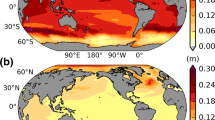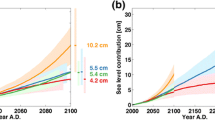Abstract
Due to complexities of creating sea-level rise scenarios, impacts of climate-induced sea-level rise are often produced from a limited number of models assuming a global uniform rise in sea level. A greater number of models, including those with a pattern reflecting regional variations would help to assure reliability and a range of projections, indicating where models agree and disagree. This paper determines how nine new patterned-scaled sea-level rise scenarios (plus the uniform and patterned ensemble mean rises) influence global and regional coastal impacts (wetland loss, dry land loss due to erosion and the expected number of people flooded per year by extreme sea levels). The DIVA coastal impacts model was used under an A1B scenario, and assumed defences were not upgraded as conditions evolved. For seven out of nine climate models, impacts occurred at a proportional rate to global sea-level rise. For the remaining two models, higher than average rise in sea level was projected in northern latitudes or around populated coasts thus skewing global impact projections compared with the ensemble global mean. Regional variability in impacts were compared using the ensemble mean uniform and patterned scenarios: The largest relative difference in impacts occurred around the Mediterranean coast, and the largest absolute differences around low-lying populated coasts, such as south, south-east and east Asia. Uniform projections of sea-level rise impacts remain a useful method to determine global impacts, but improved regional scale models of sea-level rise, particularly around semi-enclosed seas and densely populated low-lying coasts will provide improved regional impact projections and a characterisation of their uncertainties.







Similar content being viewed by others
Abbreviations
- CIS:
-
Commonwealth of Independent States
- CMIP3:
-
Coupled Model Intercomparison Project.
- DIVA:
-
Dynamic Interactive Vulnerability Assessment
- AOGCM:
-
Atmosphere–ocean General Circulation Model
- AR4:
-
Fourth Assessment Report
- ASMITA:
-
Aggregated Scale Morphological Interaction between a Tidal basin and the Adjacent coast
- GIA:
-
Glacial isostatic adjustment
- GLOBE:
-
Global Land One km Base Elevation project
References
Burkett V, Kusler J (2000) Climate change: Potential impacts and interactions in wetlands of the United States. J Am Waterw Resour Assoc 32(2):313–320
Center for International Earth Science Information Network (CIESIN), Columbia University, International Food Policy Research Institute (IFPRI), World Resources Institute (WRI) (2000) Gridded Population of the World (GPW), Version 2. Palisades. CIESIN, New York
Gregory J, Huybrechts P (2006) Ice-sheet contributions to future sea-level change. Philos Trans R Soc Lond A 364:1709–1731. doi:http://www.ncbi.nlm.nih.gov/pubmed/16782607
Hinkel J, Lincke D, Vafeidis AT, Perrette M, Nicholls RJ, Tol RSJ, Marzeion B, Fettweis X, Levermann A (2013a) Impact of future sea-level rise of global risk coastal floods. Submitted to Proc Natl Acad Sci USA.
Hinkel J, Nicholls RJ, Tol RSJ, Boot G, Vafeidis A, Wang Z, Hamilton J, Klein R (2013b) A global analysis of erosion of sandy beaches and sea-level rise: An application of DIVA. Accepted by Glob Planet Change
Hinkel J, Klein RJT (2009) Integrating knowledge to assess coastal vulnerability to sea-level rise: The development of the DIVA tool. Glob Environ Change 19:384–395
Jongman B, Ward PJ, Aerts JCJH (2012) Global exposure to river and coastal flooding: Long term trends and changes. Glob Env Change 22(4):823–835. doi:10.1016/j.gloenvcha.2012.07.004
Lowe JA, Gregory JM (2006) Understanding projections of sea level rise in a Hadley Centre coupled climate model. J Geophys Res, C, Oceans 111(C11):1–12
Manning MR, Edmonds J, Emori S, Grubler A, Hibbard K, Joos F, Kainuma M, Keeling RF, Kram T, Manning AC, Meinshausen M, Moss R, Nakicenovic N, Riahi K, Rose SK, Smith S, Swart R, van Vuuren DP (2010) Misreprentation of the IPCC CO2 emission scenarios. Nature Geosci 3(6):376–377
McFadden L, Spencer T, Nicholls RJ (2007) Broad-scale modelling of coastal wetlands: what is required? Hydrobiolgica 577:5–15
Meehl GA, Stocker TF, Collins WD, Friedlingstein P, Gaye AT, Gregory JM, Kitoh A, Knutti R, Murphy JM, Noda A, Raper SCB, Watterson IG, Weaver AJ, Zhao Z-C (2007) Global climate projections. In: Solomon S, Qin D, Manning M et al (eds) Climate change 2007: The physical science basis. Contribution of Working Group I to the Fourth Assessment Report of the Intergovernmental Panel on Climate Change. Cambridge University Press, Cambridge, UK, pp 433–497
Nakicenovic N, Swart R (2000) Emissions scenarios. Special report of the Intergovernmental Panel on Climate Change. Cambridge University Press, Cambridge, UK
Nicholls RJ (2004) Coastal flooding and wetland loss in the 21st century: Changes under the SRES climate and socio-economic scenarios. Glob Environ Change 14(1):69–86
Nicholls RJ, Cazenave A (2010) Sea-level rise and its impact on coastal zones. Science 328(5985):1717–1520. doi:10.1110.1126/science.1185782
Nicholls RJ, Wong PP, Burkett VR, Codignotto JO, Hay JE, McLean RF, Ragoonaden S, Woodroffe CD (2007) Coastal systems and low-lying areas. In: Parry ML, Canziani OF, Palutikof JP, van der Linden PJ, Hanson CE (eds) Climate change 2007: Impacts, adaptation and vulnerability. Contribution of Working Group II to the Fourth Assessment Report of the Intergovernmental Panel on Climate Change. Cambridge University Press, Cambridge, UK, pp 315–357
Nicholls RJ, Brown S, Hanson S, Hinkel J (2010) Economics of coastal zone adaptation to climate change. The World Bank, Washington, USA. http://climatechange.worldbank.org/sites/default/files/documents/DCCDP_10_CoastalZoneAdaptation.pdf Accessed July 2013
Nicholls RJ, Marinova N, Lowe JA, Brown S, Vellinga P, de Gusmão D, Hinkel J, Tol RSJ (2011) Sea-level rise and its possible impacts given a ‘beyond 4°C world’ in the twenty-first century. Philos Trans R Soc A 369:161–181. doi:10.1098/rsta.2010.0291
Pardaens AK, Lowe JA, Brown S, Nicholls RJ, de Gusmão D (2011) Sea-level rise and impacts projections under a future scenario with large greenhouse gas emission reductions. Geophys Res Lett 38:L12604. doi:10.11029/12011GL047678
Peltier WR (2000a) Global glacial isostatic adjustment and modern instrumental records of relative sea level history. In: Douglas BC, Kearny MS, Leatherman SP (eds) Sea level rise; history and consequences. Academic Press, San Diego, pp 65–95
Peltier WR (2000b) Ice4g (vm2) glacial isostatic adjustment corrections. In: Douglas BC, Kearny MS, Leatherman SP (eds) Sea level rise; history and consequences. Academic Press, San Diego
Radić V, Hock R (2011) Regionally differentiated contribution of mountain glaciers and ice caps to future sea-level rise. Nature Geosci 4:91–94. doi:10.1038/ngeo1052
Raper SCB, Cubasch U (1996) Emulation of the results from a coupled general circulation model using a simple climate model. Geophys Res Lett 23:1107–1110
Vafeidis AT, Nicholls RJ, McFadden L, Tol RSJ, Hinkel J, Spencer T, Grashoff PS, Boot G, Klein R (2008) A new global coastal database for impact and vulnerability analysis to sea-level rise. J Coast Res 24:917–924. doi:10.2112/06-0725.1
van Goor M, Zitman T, Wang Z, Stive M (2003) Impact of sea-level rise on the morphological equilibrium state of tidal inlets. Marin Geol 202:211–227. doi:10.1016/S0025-3227(03)00262–7
van Vuuren DP, Lucas PL, Hilderink H (2007) Downscaling drivers of global environmental change: Enabling use of global SRES scenarios at the national and grid scales. Glob Environ Change 17:114–130
Wöppelmann G, Marcos M (2012) Coastal sea level rise in southern Europe and the non climate contribution of vertical land motion. J Geophys Res: Oceans 117:C01007. doi:10.1029/2011JC007469
Zhang K, Douglas B, Leatherman S (2004) Global warming and coastal erosion. Clim Change 64:41–58
Author information
Authors and Affiliations
Corresponding author
Additional information
This article is part of a Special Issue on “The QUEST-GSI Project” edited by Nigel Arnell.
An erratum to this article is available at http://dx.doi.org/10.1007/s10584-013-0991-1.
Electronic supplementary materials
Below is the link to the electronic supplementary material.
ESM 1
(PDF 177 kb)
Rights and permissions
About this article
Cite this article
Brown, S., Nicholls, R.J., Lowe, J.A. et al. Spatial variations of sea-level rise and impacts: An application of DIVA. Climatic Change 134, 403–416 (2016). https://doi.org/10.1007/s10584-013-0925-y
Received:
Accepted:
Published:
Issue Date:
DOI: https://doi.org/10.1007/s10584-013-0925-y




